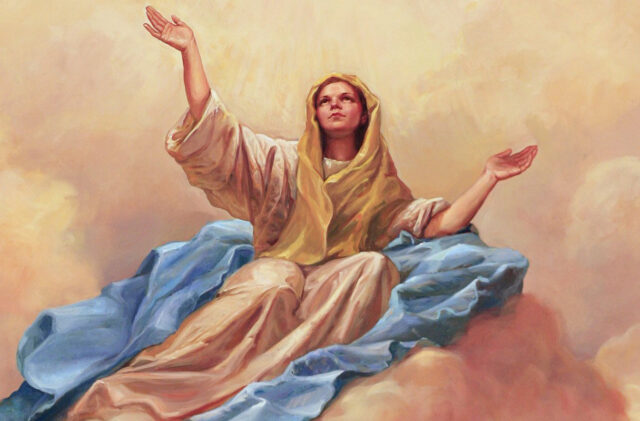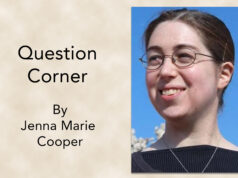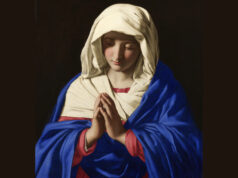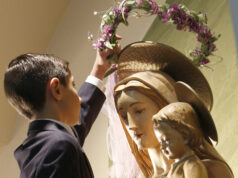
Yes, Tuesday, August 15, the Solemnity of the Assumption of the Blessed Virgin Mary into Heaven (and the Patronal Feast of the Diocese of Trenton), IS a holy day of obligation. Catholics are obliged to attend Mass either on the vigil (the evening before) or on the day itself. Rather than focus on the “obligation,” which is described in the provisions of canon law (cc. 1246 and 1247), perhaps we should consider the reasons of faith behind the obligation.
The Blessed Virgin Mary is the Mother of the Lord Jesus Christ and, as such, possesses the title and identity of “Mother of God.” Throughout the history of the church, Mary has enjoyed a singular place of honor and pre-eminence among the communion of saints. Chosen by God to be the mother of his only begotten Son, Mary was “immaculately conceived,” that is, conceived in the womb of her own mother without the stain of original sin and “full of grace” as the Angel Gabriel announced when Mary, in turn, conceived the Lord Jesus (Luke 1:28).
Similarly, because of her unique and privileged relationship to the Lord Jesus Christ, she was assumed body and soul into heaven when her life on earth was ended. These two intimately related convictions of faith definitively proclaimed and held by the church — the Immaculate Conception and the Assumption — understandably merit special recognition and observance. Hence they are both holy days of obligation..
The doctrine of the Assumption of the Blessed Virgin Mary into Heaven was defined and declared “divinely revealed dogma” (that is, infallible and beyond doubt) by Pope Pius XII in his 1950 apostolic constitution “Munificentissimus Deus” (Nov. 1, 1950).
Did Mary actually die? Neither the Scriptures nor church tradition, including Pope Pius XII’s declaration, explicitly answer that question. Throughout the centuries, however, most saints and Catholic theologians believed that she did, in fact, die but not as a result of any original or human sin — from which she was uniquely spared — but in conformity to the experience of her Son, Jesus, who died. Pope St. John Paul II explained “since Christ died, it would be difficult to maintain the contrary for his Mother … the Mother is not superior to the Son who underwent death” (General Audience, June 25, 1997, 2-3).
What is the meaning of “assumption?”
Most simply stated — and the reality is anything but simple to understand by reason alone — “the Immaculate Mother of God, the ever Virgin Mary, having completed the course of her earthly life was assumed body and soul into heavenly glory” (Pope Pius XII, MD 44). It is important to note that, unlike with Jesus her Son, church teaching does not use the terms “resurrection” or “ascension” to define or describe the “assumption” of Mary. She was not “raised from the dead” or “brought back to life” on earth nor did she “ascend into heaven by her own power.” Mary was “assumed into heaven, body and soul” by God at the end of her earthly life.
Is the doctrine of the Assumption of the Blessed Virgin Mary found in the Scriptures?
Yes and no. There is no explicit text in the Bible specific to Mary’s Assumption, but there are precedents for “assumption” found there in the cases of the Old Testament Patriarch Enoch and the Prophet Elijah — both holy men in the history of Israel who were taken up by God into heaven. Pondering Mary’s unique role in the history of salvation and her perfect union with her son, the early church made the case for her Assumption in its faith that she ultimately shared in his glory. She was, after all, present at his incarnation and birth, present with Joseph at the temple in Jerusalem, present throughout his “hidden life,” present at the first miracle at Cana, present at significant moments in his public ministry, present at his crucifixion and placed in the care of John the Beloved Disciple, present at the beginnings of the church. She could truly say of Jesus, “this is my body, this is my blood.” Scripture scholars through the centuries have also highlighted various themes in the Bible that support the church’s belief in the Assumption of Mary. Great works of Christian art depict the death or “dormition” of Mary as well as portrayals of her being taken, body and soul, into heaven. Faith in the Assumption of Mary has strong foundation throughout the church’s history.
–The meaning of the Assumption of Mary, for us
Mary’s Assumption anticipates our ultimate union with Christ. The Catechism of the Catholic Church states: ” … the Immaculate Virgin, preserved free from all stain of original sin, when the course of her earthly life was finished, was taken up body and soul into heavenly glory, and exalted by the Lord as Queen over all things, so that she might be the more fully conformed to her Son, the Lord of lords and conqueror of sin and death.”508 The Assumption of the Blessed Virgin is a singular participation in her Son’s Resurrection and an anticipation of the resurrection of other Christians” (CCC, 966).
— Mary’s Assumption is a “type” of the church and a model for all Christians. The Second Vatican Council reminded us: “By reason of the gift and role of her divine motherhood, by which she is united with her Son, the Redeemer, and with her unique graces and functions, the Blessed Virgin is also intimately united to the church. As St. Ambrose taught, the Mother of God is a type of the church in the order of faith, charity, and perfect union with Christ. For in the mystery of the church, which is itself rightly called mother and virgin, the Blessed Virgin stands out in eminent and singular fashion as exemplar both of virgin and mother” (Lumen Gentium, 63).
— Mary’s Assumption is an example and teacher of prayer. In his apostolic exhortation “Marialis Cultus,” St. Pope Paul VI observed: “… the last description of Mary’s life presents her as praying. The apostles ‘joined in continuous prayer, together with several women, including Mary the mother of Jesus, and with his brothers’ (Acts 1:4). We have here the prayerful presence of Mary in the early church and in the church throughout all ages, for, having been assumed into heaven, she has not abandoned her mission of intercession and salvation” (MC 18).
— Mary’s Assumption teaches us trust and hope. In a homily given in Washington D.C. Pope St. John Paul II preached: To succeed in your intentions, entrust yourselves to the Blessed Virgin Mary always, but especially in moments of difficulty and darkness. ‘From Mary we learn to surrender to God’s will in things. From Mary we learn to trust even when all hope seems gone. From Mary we learn to love Christ, her Son and the Son of God … Learn from her to be always faithful, to trust that God’s Word to you will be fulfilled, and that nothing is impossible with God.”
— Mary’s Assumption completes her work on earth and invites us to join her in eternity. In 2017, Pope Francis spoke to 20,000 pilgrims in St. Peter’s Square, on the Solemnity of the Assumption: “… she brings a new ability to overcome with faith the most painful and difficult moments; she brings the ability of mercy, to forgive each other, understand each other, support one another. … We ask her to keep us and support us so that we may have a strong, joyous and merciful faith. May she help us to be holy, so that we might meet with her, one day, in Heaven.”
O Mary, Mother of God, Mother of the Church, Assumed into Heaven, pray for us and lead us there.
This article has been edited for length.
Bishop David M. O’Connell, C.M. is the 10th Bishop of Trenton and former president of The Catholic University of America.







